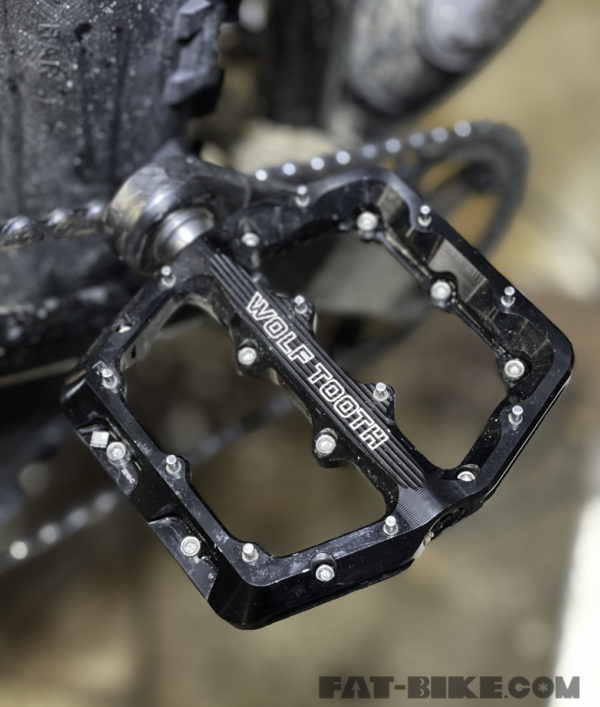
Wolftooth introduced their waveform pedals last winter and sent us a pair along with an Arctodus steel fat bike that they loaned us. I started riding the waveform pedals on that Arctodus and then moved them to a corner unit singlespeed where they provided further duty. Pedals truly take a beating on mountain bikes, and they live down in the dirt mud, slush, salt, silt, creeks, puddles, sand, rivers, and lakes. They also have to withstand being stomped on with all of any riders’, fury, and weight. In addition to all of that, they need to be able to withstand violent collisions with rock, concrete, stumps, and maybe even other bikes and Gnomes. Bike pedals take a ton of abuse.
In the winter, the waveform pedals worked admirably with the soles of the Oboz Bridger winter boots that I’ve been wearing. They are nice and grippy with a generous, concave surface riddled with 11 replaceable pins on each side of the pedal. In springtime conditions, they’ve worked equally as adeptly mated to a pair of Endura ride shoes.
The waveforms are metal. Not like Black Sabbath, but more like they’re not composite or what some people would call plastic. I was told by my Alaskan amigos that plastic doesn’t transfer a cold as quickly as metal so I’ve always run composite platform pedals. The waveforms are CNC machined from a block of aluminum which is probably stronger than any composite pedal but they’re also considerably more expensive. These pedals are made and assembled right there in the land of 10,000 lakes in Minnesota USA. High-quality made-in-the-USA bicycle components cost more to make so they usually are more expensive. The waveforms have a dual concave profile and feature 22 stainless pins that are replaceable. They even come in two sizes and several colors. Small – 105X 99 mm at 373 g and large – 112X106MM weighing 384 g. They come in black, blue, orange, ultra, violet, purple, espresso, olive, red, and raw silver.
The internals of these pedals are similar to most modern platform pedals. The waveforms list, three low friction sealed cartridge bearings, and one AGUS bushing with radial seals to protect the internal components against contamination from the elements. The internals of the waveforms are serviceable, and Wolftooth supports your “right to repair” and sells the parts and components on their waveform web page.

This is a quality set of aluminum platform pedals. They look good. They feel good (when ridden). They work quite well or perhaps you might even say that they perform admirably. I just can’t help comparing the cost of them to composite pedals. However, there are rocky riding environments where CNC-machined aluminum pedals are better suited to survive compared to any composite pedal. I’ve tried to rebuild pedals after stomping on stomping them to death for several seasons and was somewhat disappointed with the results. The rebuilt pedals never felt as smooth as a new set. So I guess that’s made me treat pedals more like a BIC lighter. These pedals are like a well-machined butane lighter from a James Bond movie. So if you’re seeking a set of CNC-machined aluminum shin shredders, and have a healthy pedal budget. The Wolftooth components waveform platforms should be on your radar. A pair of espresso waveforms would look majestic on Carlos.

For more information about Wolftooth waveform pedals visit – https://www.wolftoothcomponents.com/products/waveform-aluminum-pedals



Brought up this article at trail work the other morning. The general consensus was that pedals are for the most part as disposable as a Bic.